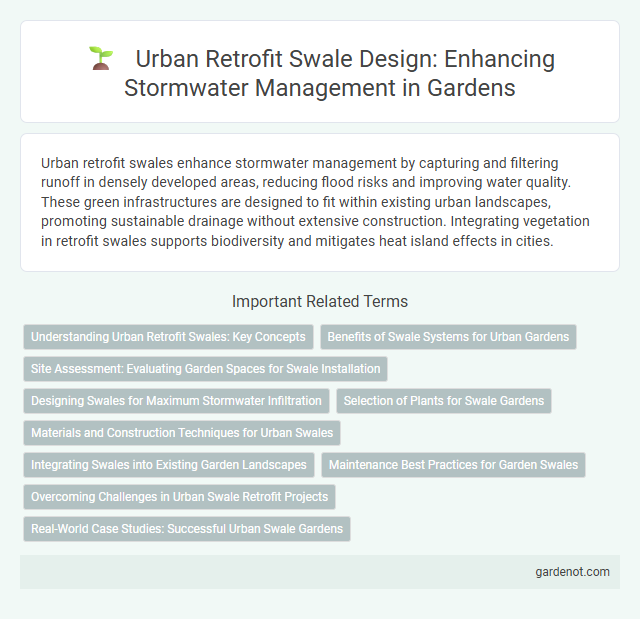Urban retrofit swales enhance stormwater management by capturing and filtering runoff in densely developed areas, reducing flood risks and improving water quality. These green infrastructures are designed to fit within existing urban landscapes, promoting sustainable drainage without extensive construction. Integrating vegetation in retrofit swales supports biodiversity and mitigates heat island effects in cities.
Understanding Urban Retrofit Swales: Key Concepts
Urban retrofit swales are engineered landscape features designed to manage stormwater by capturing, slowing, and infiltrating runoff in developed areas. They reduce urban flooding, improve water quality, and support groundwater recharge by mimicking natural hydrological processes. Incorporating soil amendments and native vegetation enhances their effectiveness and biodiversity benefits in urban environments.
Benefits of Swale Systems for Urban Gardens
Urban retrofit swale systems enhance stormwater management by capturing and infiltrating runoff, reducing urban flooding and soil erosion in garden landscapes. These swales improve soil moisture retention, promoting healthier plant growth and increasing biodiversity in urban gardens. By filtering pollutants from runoff, swale systems contribute to cleaner groundwater and support sustainable urban ecosystems.
Site Assessment: Evaluating Garden Spaces for Swale Installation
Evaluating garden spaces for swale installation involves analyzing soil permeability, slope gradient, and existing vegetation to ensure effective water infiltration and retention. Site assessment includes testing soil infiltration rates and mapping topography to identify natural flow paths and low points for optimal swale placement. Consideration of proximity to structures and underground utilities is essential to prevent damage and maximize stormwater management benefits.
Designing Swales for Maximum Stormwater Infiltration
Urban retrofit swales enhance stormwater management by maximizing infiltration through strategic grading, vegetative selection, and soil amendment. Designing swales with permeable soils and native, deep-rooted plants improves water absorption while reducing runoff volume. Incorporating features like check dams and sediment traps also optimizes pollutant removal and prolongs infiltration capacity.
Selection of Plants for Swale Gardens
Selection of plants for urban retrofit swale gardens prioritizes native, drought-tolerant species with deep root systems to enhance water infiltration and soil stability. Species such as Carex, Juncus, and native grasses effectively reduce runoff while supporting local biodiversity. Incorporating diverse perennials and shrubs also aids in pollutant filtration and increases swale resilience against urban stressors.
Materials and Construction Techniques for Urban Swales
Urban retrofit swales utilize permeable materials such as engineered soil mixes, gravel, and native vegetation to enhance water infiltration and pollutant removal. Construction techniques emphasize precise grading, compaction control, and installing underdrain systems to manage stormwater efficiently in constrained urban environments. The integration of modular prefabricated components and bioengineered stabilization methods improves durability and maintenance in retrofit applications.
Integrating Swales into Existing Garden Landscapes
Urban retrofit swales enhance stormwater management by integrating natural water filtration systems into existing garden landscapes, reducing runoff and improving soil moisture retention. These swales can be strategically designed to fit within limited backyard spaces, utilizing native plants to optimize absorption and minimize erosion. Incorporating swales into residential gardens promotes sustainable urban drainage, contributing to improved groundwater recharge and biodiversity.
Maintenance Best Practices for Garden Swales
Effective maintenance of urban retrofit garden swales involves regular inspection to ensure proper water flow and prevent sediment buildup that can clog the system. Periodic removal of debris, vegetation trimming, and erosion control measures are essential to maintain swale functionality and longevity. Implementing routine soil health monitoring and managing invasive plant species support sustained stormwater infiltration and urban runoff management.
Overcoming Challenges in Urban Swale Retrofit Projects
Urban swale retrofit projects face challenges such as limited space, soil compaction, and stormwater runoff variability. Effective solutions include using engineered soil amendments, modular swale designs, and advanced hydrological modeling to optimize drainage performance. Collaboration between urban planners, engineers, and ecologists enhances project success by integrating sustainable water management with urban infrastructure.
Real-World Case Studies: Successful Urban Swale Gardens
Urban retrofit swales have proven effective in managing stormwater and improving urban green spaces by replicating natural water infiltration processes. Case studies such as Seattle's citywide implementation demonstrate significant reductions in runoff volume and pollutant loads, enhancing groundwater recharge and reducing urban flooding. Projects in Melbourne and Portland further illustrate how retrofitted swale gardens promote biodiversity, improve air quality, and provide aesthetic value in densely populated areas.
Urban retrofit swale Infographic

 gardenot.com
gardenot.com